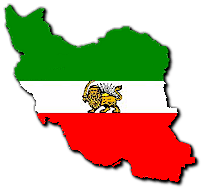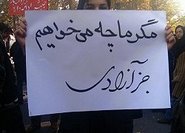Alliance For democracy In Iran
Please have a look at my other weblog, Iran Democracy - http://irandemocray.blogspot.com/
IMPERIAL EMBLEM

PERSIA
Shahanshah Aryameher
S U N OF P E R S I A
Iranian Freedom Fighters UNITE
Saturday, July 28, 2007
Taliban in first heat-seeking missile attack : By Tom Coghlan in Kabul
Frontline: Reports from Iraq and Afghanistan
Taliban militants have used a heat-seeking surface-to-air missile to attack a Western aircraft over Afghanistan for the first time. The attack with a weapon believed to have been smuggled across the border with Iran represents a worrying increase in the capability of the militants which Western commanders had long feared. The Daily Telegraph has learnt that the Taliban attempted to bring down an American C-130 Hercules aircraft flying over the south-western province of Nimroz on July 22. The crew reported that a missile system locked on to their aircraft and that a missile was fired. It closed in on the large C-130 aircraft, pursuing it as the pilots launched a series of violent evasive manoeuvres and jettisoned flares to confuse the heat sensors in the nose of the missile. Crew members said that they saw what they believe was a missile passing very close to the aircraft. The C-130 was not damaged in the attack. Nato officials yesterday refused to confirm or deny that such an attack had taken place. "If there was such an incident of the type you describe in Nimroz it is classified," said a Nato spokesman. "I can't release it, if in fact it did occur." However, a surface-to-air missile alert was put out for Western aircraft travelling in the south-west of Afghanistan in the last week, which affected both civilian and military aircraft. It was confirmed by civilian air operators in Helmand province. It remains in place. Western military commanders have been aware of concerted efforts by the Taliban to obtain shoulder-launched surface-to-air missiles, so-called Manpads (man portable air defence system). The recent attack was probably with an SA7 shoulder-launched missile, an elderly model of Soviet or Chinese origin. Though relatively primitive they are still a potent weapon, particularly against low-flying helicopters, such as the workhorse Chinook transporters used by British forces in the southern Helmand province. The C-130 attacked in Nimroz was flying at 11,000ft at the time of the attack, which is within the 2.5-5 km range of a shoulder-launched missile system such as the SA7. Though the West supplied hundreds of sophisticated Stinger heat-seeking missiles to the Afghan Mujaheddin in the 1980s, they are not thought to be still usable because of the deterioration of their sophisticated electronics and battery systems. As a contingency in 2002, the United States government offered an amnesty on Stingers and successfully bought back many of the missiles still in the arsenals of Afghan warlords for $40,000 a missile. To date, the Taliban has shot down a number of Western helicopters, but only through the use of unguided rocket-propelled grenades, which have a range of only 500 yards. In April members of the Special Boat Service operating in Nimroz province intercepted several truck loads of weapons coming across the Iranian border, including a working SA7 missile. It was one of a number of recent weapon caches that Western officials claim have been seized on the border with Iran, fuelling allegations by Britain and America that Iran, or elements within the Iranian government, have begun supplying arms to the Taliban. Hundreds of SA7 missiles disappeared into the black market in Iraq in the aftermath of the fall of Saddam Hussein, where they have since been used to shoot down dozens of helicopters and aircraft, reportedly including a British C-130 in 2005. Meanwhile, a Taliban spokesman said that the group would allow more time for an envoy from Seoul to travel to join talks for the release of 22 South Korean hostages. But the spokesman repeated the threat that militants would kill the 22 Christian missionaries.
Taliban militants have used a heat-seeking surface-to-air missile to attack a Western aircraft over Afghanistan for the first time. The attack with a weapon believed to have been smuggled across the border with Iran represents a worrying increase in the capability of the militants which Western commanders had long feared. The Daily Telegraph has learnt that the Taliban attempted to bring down an American C-130 Hercules aircraft flying over the south-western province of Nimroz on July 22. The crew reported that a missile system locked on to their aircraft and that a missile was fired. It closed in on the large C-130 aircraft, pursuing it as the pilots launched a series of violent evasive manoeuvres and jettisoned flares to confuse the heat sensors in the nose of the missile. Crew members said that they saw what they believe was a missile passing very close to the aircraft. The C-130 was not damaged in the attack. Nato officials yesterday refused to confirm or deny that such an attack had taken place. "If there was such an incident of the type you describe in Nimroz it is classified," said a Nato spokesman. "I can't release it, if in fact it did occur." However, a surface-to-air missile alert was put out for Western aircraft travelling in the south-west of Afghanistan in the last week, which affected both civilian and military aircraft. It was confirmed by civilian air operators in Helmand province. It remains in place. Western military commanders have been aware of concerted efforts by the Taliban to obtain shoulder-launched surface-to-air missiles, so-called Manpads (man portable air defence system). The recent attack was probably with an SA7 shoulder-launched missile, an elderly model of Soviet or Chinese origin. Though relatively primitive they are still a potent weapon, particularly against low-flying helicopters, such as the workhorse Chinook transporters used by British forces in the southern Helmand province. The C-130 attacked in Nimroz was flying at 11,000ft at the time of the attack, which is within the 2.5-5 km range of a shoulder-launched missile system such as the SA7. Though the West supplied hundreds of sophisticated Stinger heat-seeking missiles to the Afghan Mujaheddin in the 1980s, they are not thought to be still usable because of the deterioration of their sophisticated electronics and battery systems. As a contingency in 2002, the United States government offered an amnesty on Stingers and successfully bought back many of the missiles still in the arsenals of Afghan warlords for $40,000 a missile. To date, the Taliban has shot down a number of Western helicopters, but only through the use of unguided rocket-propelled grenades, which have a range of only 500 yards. In April members of the Special Boat Service operating in Nimroz province intercepted several truck loads of weapons coming across the Iranian border, including a working SA7 missile. It was one of a number of recent weapon caches that Western officials claim have been seized on the border with Iran, fuelling allegations by Britain and America that Iran, or elements within the Iranian government, have begun supplying arms to the Taliban. Hundreds of SA7 missiles disappeared into the black market in Iraq in the aftermath of the fall of Saddam Hussein, where they have since been used to shoot down dozens of helicopters and aircraft, reportedly including a British C-130 in 2005. Meanwhile, a Taliban spokesman said that the group would allow more time for an envoy from Seoul to travel to join talks for the release of 22 South Korean hostages. But the spokesman repeated the threat that militants would kill the 22 Christian missionaries.
Subscribe to:
Post Comments (Atom)
























 اخبار مربوط به زندانیان سیاسی و نقض حقوق بشر
اخبار مربوط به زندانیان سیاسی و نقض حقوق بشر

















 Tulips in Holland
Tulips in Holland












No comments:
Post a Comment